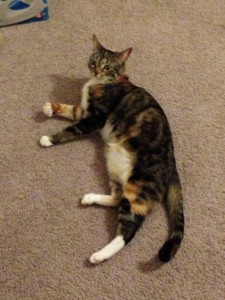 We’ve written on numerous occasions about America’s pet obesity epidemic and have provided tips on how to slim and trim your pet. We’re honored to welcome Rainier Fuclan as a guest blogger with a new canine or feline weight loss plan to help our pets lose weight safely. Rainier Fuclan is a marketing strategist, freelance writer and pet lover! When he’s not busy working you can find him at home playing with his dog Peanut and cat Anya.
We’ve written on numerous occasions about America’s pet obesity epidemic and have provided tips on how to slim and trim your pet. We’re honored to welcome Rainier Fuclan as a guest blogger with a new canine or feline weight loss plan to help our pets lose weight safely. Rainier Fuclan is a marketing strategist, freelance writer and pet lover! When he’s not busy working you can find him at home playing with his dog Peanut and cat Anya.
Spring is almost upon us, and with the warmer weather comes the realization that some of us will need to take off a few pounds we’ve gained over the winter months. While you’re taking a critical eye to your waistline, now might be a good time to see whether your four-legged friends could afford to shed a few pounds as well. According to the Association for Pet Obesity Prevention, more than 50 percent of cats and dogs are currently overweight, and one-third of those pets are considered obese, or weighing more than 30 percent over what is considered a healthy weight for them.
Having an overweight or obese pet can be more problematic than just having a few extra pounds of pet to love. Pet owners spend millions of dollars annually to treat obesity-related conditions, and aside from the financial strain on a pet owner’s pocketbook, the pets themselves can suffer from conditions such as kidney failure, diabetes, and cancer.
Curious to know whether your pet could stand to lose a few pounds for their health? On a recent episode of Who Let the Dogs Out, veterinarian Karen “Doc” Halligan provided some ways to check whether your pet might be overweight. An easy way is to visually inspect your pet. When you pet your dog or cat, can you feel their backbone or ribs? If so, your pet is most likely healthy as long as the ribs or backbone are not visually apparent (protruding bones can be sign your pet is underweight). If you can’t feel their ribs or backbone, your pet might be overweight.
Another visual cue in pets is their tummy tuck – no, not the cosmetic surgery procedure. When you look at your pet’s profile, can you see where their tummy tucks just behind their last rib and leading up into their hind legs? This tuck signifies a healthy weight for your pet. If your dog or cat’s stomach hangs down and doesn’t feature a tuck, your pet might be overweight.
 If after looking at your pet you believe that he or she might be overweight, you’ll want to consult with your vet to confirm this, as well as figure out an appropriate diet plan for your pet to lose weight. Just like people, the safest way to lose weight is to cut back on calories and increase exercise, all in moderation. If your pet food features a low calorie version of the flavor your pet enjoys, you can consider switching to that variety. However, a good weight loss diet should contain not only lower calorie options, but also appropriate levels of protein to maintain lean muscle mass and fiber that will keep your pet feel full longer. Natural Balance offers a line of food specifically formulated for overweight pets (which is available at That Fish Place – That Pet Place’s retail store) that features balanced nutrition appropriate for dogs and cats that need to lose a little weight.
If after looking at your pet you believe that he or she might be overweight, you’ll want to consult with your vet to confirm this, as well as figure out an appropriate diet plan for your pet to lose weight. Just like people, the safest way to lose weight is to cut back on calories and increase exercise, all in moderation. If your pet food features a low calorie version of the flavor your pet enjoys, you can consider switching to that variety. However, a good weight loss diet should contain not only lower calorie options, but also appropriate levels of protein to maintain lean muscle mass and fiber that will keep your pet feel full longer. Natural Balance offers a line of food specifically formulated for overweight pets (which is available at That Fish Place – That Pet Place’s retail store) that features balanced nutrition appropriate for dogs and cats that need to lose a little weight.
In addition to the lowered caloric intake, you’ll want to increase the exercise your pet gets on a daily basis. Just like with any human starting a weight loss plan, it’s better to start slow and work your way up in slow increments. If your pet rarely gets any exercise, start off slow by taking your dog around the block on a short, slow walk. Each week, try to increase your distance by 15 percent to build up lean muscle. For fat cats, it’s going to be harder to get them to exercise as they generally don’t like being led around the neighborhood on a leash. Instead, try to get them to play with you in the evening as they are just beginning their days. This can help increase their activity levels while not encouraging them to play during the night while you’re trying to sleep.
As with all weight loss plans, first consult with a medical professional to ensure that your cat or dog can lose weight safely. By taking the gradual approach, your pet won’t feel deprived of food, and you can both form better habits and keep the weight off.
 That Pet Blog That Pet Place Pet Blog
That Pet Blog That Pet Place Pet Blog


